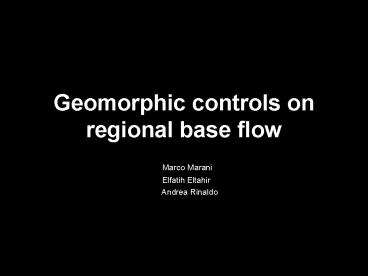Geomorphic controls on regional base flow - PowerPoint PPT Presentation
1 / 26
Title:
Geomorphic controls on regional base flow
Description:
On the asymmetric response of aquifer water level to floods and droughts in Illinois ... Aquifer transmissivity. T=Kb=L2/t. Effects of geomorphic controls ... – PowerPoint PPT presentation
Number of Views:45
Avg rating:3.0/5.0
Title: Geomorphic controls on regional base flow
1
Geomorphic controls on regional base flow
- Marco Marani
- Elfatih Eltahir
- Andrea Rinaldo
2
Study Summary
- Recharge
- Geomorphic and topographic influences
- Groundwater response
3
Background Summary
- Signatures
- Geomorphic variance
- Nonlinearity in groundwater rating curves
4
On the asymmetric response of aquifer water level
to floods and droughts in IllinoisEltahir and
Yeh1999
- Floods and droughts in Illinois from 1983-1994
- Variables flux of atmospheric water vapor,
precipitation, soil, moisture content,
groundwater level, river flow - Aquifers respond differently
5
Seasonal Cycles
6
Time series of normalized anomalies
7
(No Transcript)
8
Physical basis of the nonlinear groundwater
rating curve
- qgKhr2DL
- qg base flow discharge
- K hydraulic conductivity
- hr average elevation
- of aquifer
- D drainage density
- L channel length
9
Theoretical-Groundwater Rating Curves
- Water head fluctuations
- Aquifer thickness 100-102 m
- Planar 103-106 m
- Groundwater curve generated by steady states
10
Aquifer water level and drainage density
- Usual definitionDdL/A
- Depends on geomorphic controls
- Topographically concave sites
11
Aquifer transmissivity
- TKbL2/t
- Effects of geomorphic controls
- Geomorphic heterogeneity and vertical variability
12
Basic Continuity Equation
- r net recharge
- T reference regional transmissivity
13
Components
Assumption of NO FLOW Seepage Face
14
(No Transcript)
15
GW surface with topography
16
Saturation with recharge (r)
17
Robustness of model
18
(No Transcript)
19
Variance
20
Variance and Stream flow
21
Topographical influences
Vertical length Energy Gradient
22
Topography compared to GW
23
Density
24
(No Transcript)
25
Conclusion
- Groundwater is important for base flow
- Topography can be used to mimic groundwater
conditions to estimate base flow - Variance plays a role, but its topography that
has the controlling factors - With this study, can decrease the use of
groundwater models
26
No questions?
- GREAT!































